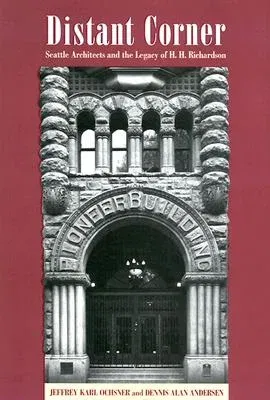On the afternoon of 6 June 1889, a fire in a cabinet shop in downtown
Seattle spread to destroy more than thirty downtown blocks covering 116
acres. Disaster soon became opportunity as Seattle's citizens turned
their full energies to rebuilding: widening and regrading streets,
laying new water pipes and sewer lines, promulgating a new building
ordinance requiring construction in the commercial core, and creating a
new professional fire department. A remarkable number of buildings, most
located in Seattle's present-day Pioneer Square Historic District, were
permitted within a few months and constructed within a few years of the
Great Seattle Fire. As a result, the post-fire rebuilding of Seattle
offers an extraordinarily focused case study of late-nineteenth-century
American urban architecture.
Seattle's architects, seeking design solutions that would meet the new
requirements, most often found them in the Romanesque Revival mode of
the country's most famous architect, Henry Hobson Richardson. In October
1889, Elmer Fisher, Seattle's most prolific post-fire architect,
specifically cited the example of H. H. Richardson in describing the
city's new buildings. In contrast to Victorian Gothic, Second Empire,
and other mid-nineteenth-century architectural styles, Richardson's
Romanesque Revival vocabulary of relatively unadorned stone and brick
with round-arched openings conveyed strength and stability without
elaborate decorative treatment. For Seattle's fire-conscious architects
it offered a clear architectural system that could be applied to a
variety of building types - including office blocks, warehouses, and
hotels - and ensure a safer, progressive, and more visually coherent
metropolitan center.
Distant Corner examines the brief but powerful influence of H. H.
Richardson on the building of America's cities, and his specific
influence on the architects charged with rebuilding the post-fire city
of Seattle. Chapters on the pre-fire city and its architecture, the
technologies and tools available to designers and builders, and the rise
of Richardson and his role in defining a new American architecture
provide a context for examining the work of the city's architects.
Seattle's leading pre- and post-fire architects - William Boone, Elmer
Fisher, John Parkinson, Charles Saunders and Edwin Houghton, Willis
Ritchie, Emil DeNeuf, Warren Skillings, and Arthur Chamberlin - are
profiled. Distant Corner describes the new post-fire commercial core
and the emerging network of schools, firehouses, and other public
institutions that helped define Seattle's neighborhoods. It closes with
the sudden collapse of Seattle's economy in the Panic of 1893 and the
ensuing depression that halted the city's building boom, saw the closing
of a number of architects' offices, and forever ended the dominance of
Romanesque Revival in American architecture.
With more than 200 illustrations, detailed endnotes, and an appendix
listing the major works of the city's leading architects, Distant
Corner offers an analysis of both local and national influences that
shaped the architecture of the city in the 1880s and 1890s. It has much
to offer those interested in Seattle's early history, the building of
the city, and the preservation of its architecture. Because this period
of American architecture has received only limited study, it is also of
importance for those interested in the influence of Boston-based H. H.
Richardson and his contemporaries on American architecture at the end of
the nineteenth century.

